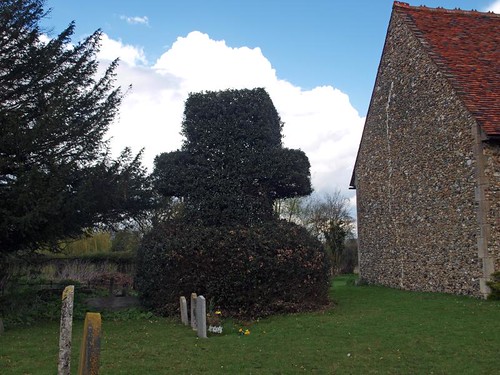British History online says: The parish church of ST. MARY consists of nave, apse, south porch, and combined north vestry and organ chamber. The walls are of flint rubble. The porch is of timber. In 1872 the church was largely rebuilt and very little medieval work now remains.
Nothing is left of the pre-13th-century church except the font (see below). The nave was probably rebuilt in the 14th century. It retains two windows, much restored, of this date. The south window has a chamfered hood-mould externally and two much decayed head stops. The braced collar-beam roof appears to be partly ancient. The only other original feature is the trefoil-headed piscina, which is probably of the 14th century and which has been reset in the apse.
The square font bowl is of the late 12th century and is similar in character to those in some neighbouring parishes. The base is an addition of 1872 and the carving of the bowl was probably re-cut at the same time.
ST MARY THE VIRGIN. Mostly of 1872. - FONT. Square, c. 1200. The four sides have decoration with a trail of stylized foliage of the usual Norman type, three fleur-de-lis, sun, moon, a whorl, two roses, and two rosettes, and two four-petalled flowers or rather quatrefoils with rose centres. This latter detail especially makes it likely that the sculptural representations have been re-cut. - PLATE. Fragmentary Cup of 1562 and Cup of 1563; undated contemporary Paten.
LITTLE LAVER. Its village group clusters about a deep wide pool which would have pleased old Izaak Walton; we found his disciples sitting patiently under the trees. The church, the great barn, and the manor house have all tiled roofs. The church walls are 600 years old and have heads at the windows; the chancel has been rounded into an apse. The wonderful font is famous hereabouts; it was made about the year 1200 and its sloping sides have fleur-de-liys, crescents, stars, and leaves, all perfect.
Flickr.
Flickr.


No comments:
Post a Comment